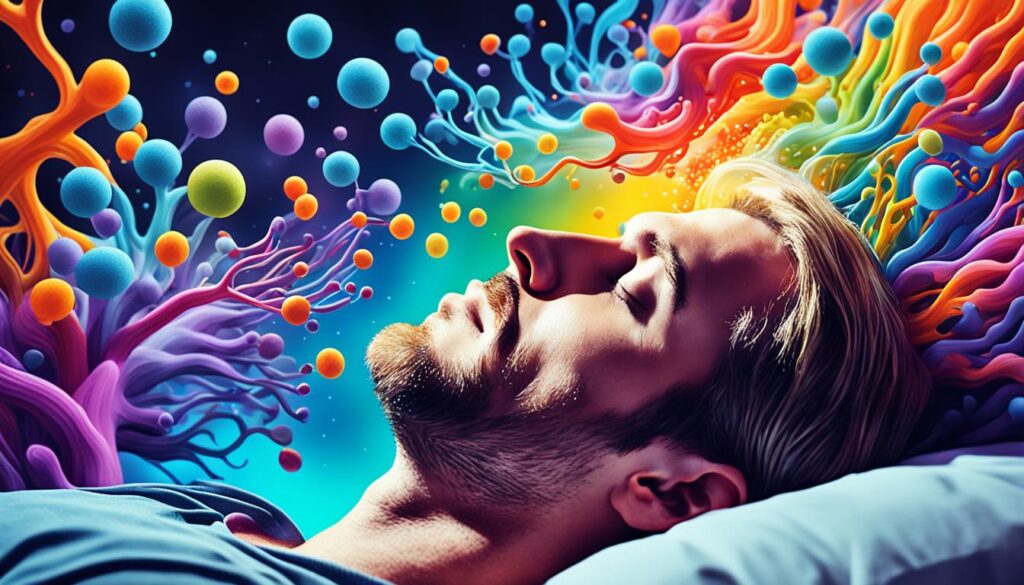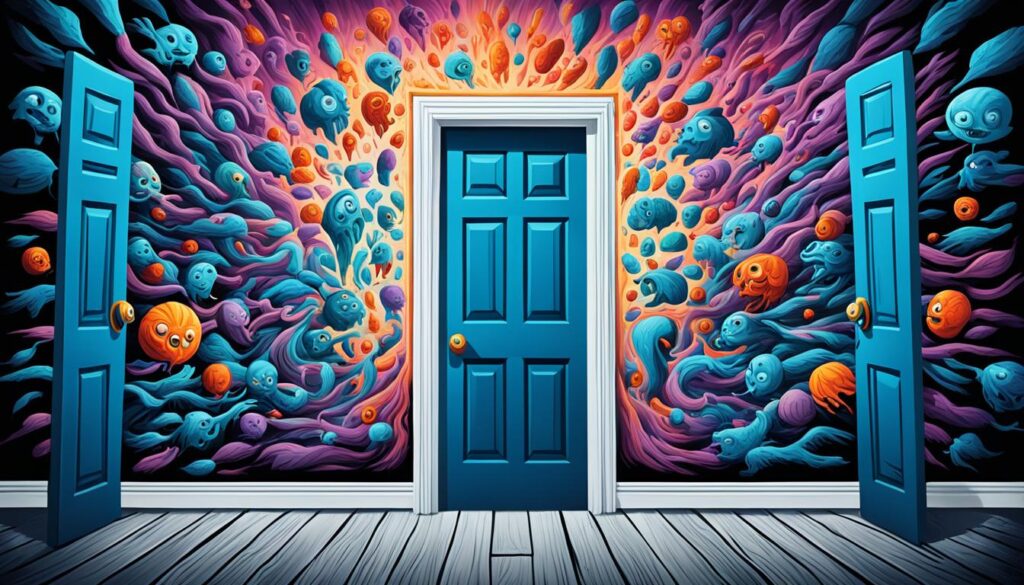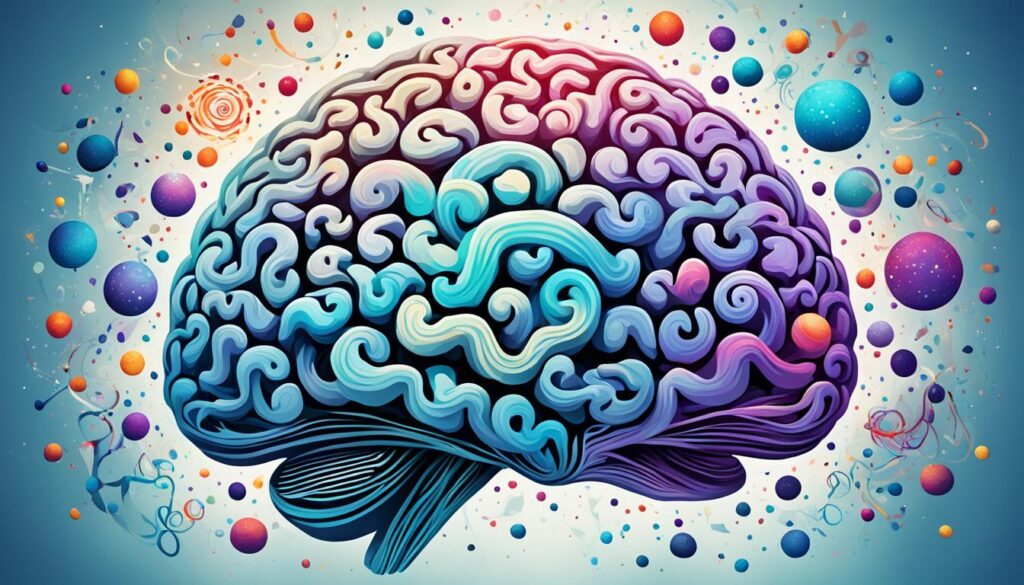For ages, people have wondered about dreams and their meanings. In ancient times, dreams were thought to predict the future. This idea changed with Sigmund Freud and Carl Jung. They believed dreams reveal our hidden desires and thoughts.
Today, science has enhanced our understanding of dreams. It has uncovered many secrets about why we dream and what our dreams might signify. These new insights have made the study of dreams even more fascinating.
Key Takeaways:
- In 1973, the Annual Review of Psychology identified two distinct stages of sleep: slow wave sleep (non-REM sleep) and rapid eye movement (REM) sleep.
- Rapid Eye Movement (REM) sleep, discovered in the 1950s, is a stage during which brain activity is more active.
- Most dreams feature familiar people, places, and everyday activities, according to research conducted in the late 1970s.
- Dream content can be scored and quantified using a quantitative approach developed by Allan Hobson.
- The invention of the electroencephalogram (EEG) by Hans Berger in the 1920s enabled researchers to record electrical brain activity, revolutionizing sleep and dream research.
Early studies on dreams have helped us gain insights into the reasons for dreaming. These findings have been quite enlightening.
On a typical night, people dream for about two hours. Dreams can happen in any sleep stage but are most vivid during REM sleep. REM sleep mostly occurs in the second half of the sleep cycle, just before waking up1.
Theories of Dream Interpretation
Sigmund Freud, a well-known psychoanalyst, and Carl Jung, his top student, are big names in dream study. Freud thought dreams show secret wishes and things we don’t even know we want2. He said dreaming helps us deal with our hidden issues2. Jung, on the other hand, saw dreams as windows into our deeper minds. He believed dreams tell us universal stories and show powerful symbols2.
Other researchers, like Allan Hobson and Robert McCarley, have their own take. They say dreams are the brain’s way of making sense of random signals in REM sleep2. The brain tries to turn these signals into stories we can understand2.
Freud talked about manifest and latent content in dreams. He said we have to dig deep to understand what dreams really mean3. To unlock the hidden messages, he used methods such as symbol analysis3. Dreams, for Freud, were keys to our true desires and conflicts3.
But, many experts have different views on dreams. They say dream meanings change from person to person, based on their life and culture3. Freud warned against applying standard symbols to all dreams3. He believed we should look within ourselves to find what our dreams truly tell us. He did not like dream dictionaries3.
The Role of REM Sleep in Dreaming
Rapid Eye Movement (REM) sleep is key for when we dream most. Our brains show signs of being awake during REM. This stage makes our eyes move fast, our brain waves go wild, and stops our muscles for a bit. It’s when we have the most colorful and memorable dreams.
It’s clear that REM sleep helps us remember dreams. If we wake up right after REM sleep, we’re more likely to say what we dreamed. Scientists found that certain brain waves help us remember our dreams well4. This shows how dreaming links to how we make memories.
Not just that, but REM sleep shapes how our dreams feel and what happens in them. Dreams in REM are wild and full of feelings, showing our memory and emotion centers at work4. In comparison, dreams outside REM are quite different, mostly filled with ideas and not so vivid4.
REM sleep’s effects aren’t just about dreams. They also help our thinking and how we feel. Adults need about two hours of REM every night5. This sleep stage, with other parts, forms a full cycle that lasts around 90 to 120 minutes5. Babies can spend a lot of their sleep time (about eight hours) in REM. As we grow, the need for REM lessens, down to about two hours each night5.
And REM isn’t just for us. Animals like cats and ferrets get REM sleep too. Some spend a lot of each day dreaming, up to eight hours5. REM sleep helps after we learn new things, aiding in remembering it all5. But not getting enough REM can mess with forming new memories5.
So, REM sleep is vital for dreaming, memory, and overall brain health. It’s when our dreams come alive and bright. Knowing about REM helps unlock the mystery of dreams.


The Relationship Between Dreams and Memory
Dreams are key in the interesting process of memory consolidation. When we sleep, our brains work hard to organize and solidify our memories. This makes our experiences into a whole story. The link between dreams and memory has fascinated scientists for a long time.
Studies say dreams help our memory and emotions. Dreams that are vivid and intense connect with brain parts like the amygdala and hippocampus. These parts help us remember things and deal with our emotions. So, dreaming is a way for our minds to deal with memories and emotions offline6.
Memory consolidation turns short memories into long-lasting ones. During sleep, in stages like REM, our brains practice and reorganize these memories. This strengthens the connections in our brains for learning and memories7.
Dreaming also helps regulate our emotions. When we dream of something, our brain turns that experience into a memory. This helps separate the intense emotion from the original event. In turn, we can understand and deal with these emotions better6. This process helps make our emotions stable and strengthens our mind.
New studies show that dreams improve how well we remember and think. For instance, dreaming about something we learned can improve how well we do, more than just practicing awake8. Dreams seem to help us learn and remember in a special way.
Our dreams often connect to our everyday lives. They might show our past memories or current worries. Dreams usually mix in recent memories, especially when we’re in NREM sleep. In REM sleep, however, dreams tend to be less connected and more random7.
The type of memories in our dreams changes with each sleep stage. NREM dreams might have clearer, past memories. REM dreams are usually more jumbled, and these differences show how our dreams change as we sleep. This change highlights how different sleep stages are related to memory processing7.
Research about how dreams and memory work together is truly interesting. It helps us understand more about how our brains work. Dreams are more than just stories at night. They give us a peek into the complex process of making and keeping memories678.


In short, dreams are critical for good memory and emotional health. So, the next time you dream, know it’s not just a story. It’s an important process for your mind, shaping your memories and experiences.
Dreaming and Emotional Processing
Dreams are key in handling emotions, blending our deepest feelings and experiences. They give us a peek into how our minds handle emotions. This helps us manage our mental health.
From studies, we know our dreams often feel more emotional than real life. This tells us a lot about our hidden feelings. Our dreams can shine a light on our true emotional health.
Experts think dreams help us deal with bad feelings from rough experiences. This makes us less worried and anxious. It’s like our mind’s way of cleaning up after negative events.
Dreaming is also tied to dealing with danger. It might help us practice reacting to threats without real harm. So, it prepares us for tough situations in life.
Studies show dreaming can change how we feel about tough times. People often feel more light-hearted about bad events after dreaming about them9.
Our day-to-day life shapes our dreams. This helps us process feelings and grow emotionally. Dreams connect us to our inner thoughts and help us understand them better.
Nightmares are a big issue for those with PTSD. They can be replays of past traumas10. Yet, facing these nightmares might help with healing in a safe space.
Dreaming and its role in dealing with trauma isn’t confined to some groups10. It can be important for anyone struggling emotionally, showing the wide impact of dreams.
Dreams open a door to our feelings, aiding in emotional sorting and understanding. They are a powerful tool for growth and insight, found in everyone’s sleep. They offer more than just stories at night.


Lucid Dreams and Nightmare
Have you ever realized you were dreaming while still asleep? That’s called a lucid dream. It gives us a peek into the secrets of our sleeping minds. There’s also a scary side to this called lucid nightmares.
In a lucid dream, you can act just like you do in real life. You talk to people who seem real, which can make the dream feel as if it’s actually happening. This is where it gets cool. Some people can change the dream’s story mid-dream. It’s like being the director of your own movie.
But what about those bad dreams that you know you’re stuck in? In these nightmares, your body can feel like it’s really in danger. Some dream characters seem to be able to make our hearts race or make us feel like we’re dying11. This shows how our minds and bodies work together even when we’re asleep.
Lucid dreaming mainly happens during REM sleep, where our eyes move fast, and our brain is very active. But it’s not just confined to this phase. It can slip into other sleeping states too11. Scientists can see our brains are different when we’re in these dreams. They look at things like brain waves to figure this out.
In fact, new studies from the journal SLEEP looked at what happens in our brains when we have lucid dreams. They found something interesting. Parts of the brain that help us think during the day light up. This makes us think lucid dreaming could really affect how we think and feel while awake11.
We’re still learning lots about lucid dreaming. There’s still a lot we don’t know, especially about those scary lucid nightmares. But scientists are working hard to understand more about what happens when we dream.


Did you know many people have had lucid dreams? Over half of adults have had at least one. And about a quarter have them often, like once a month. They usually last about 14 minutes12. If you’re open to new experiences, you might have them more often.
But be careful. Trying too hard to have lucid dreams might mess up your sleep. It can be risky for your health. And not everyone feels good after having them13.
Yet, there are some good things. For those suffering from bad dreams due to trauma, lucid dreaming might help. It could also lower how anxious or sad you feel sometimes. But, for people who might have serious mental issues, it can be dangerous13. So, if you’re going to try lucid dreaming, talk to a doctor first.
Neuroscience and Dream Research
Scientists have long studied how our brains and dreams are connected. Thanks to EEG technology, we’ve learned a lot. This tech shows us different stages of sleep, like REM sleep. This stage is when we dream the most. In REM sleep, our brain works differently than when we’re awake. The part that helps with short-term memory isn’t as active. But other areas linked to emotions are very busy14.
Neuroscience has also looked into how our dreams help us remember things. They found that dreaming activates parts of the brain that help with memory. This helps memories get organized and stored better. Sleep is really important for these memory functions. It helps us learn and remember new information1516.
But, some findings suggest that if someone is depressed, their memory might not improve during REM sleep. This could make it hard for them to form new memories15.
Dreams happen in different sleep stages, not just in REM sleep. Yet, why we dream is still a mystery to science15. Some studies, like ones with people who can control their dreams (lucid dreamers), have shown some interesting things. These studies look at the brain activity of dreamers. They’ve found that dream experiences can feel very real. For example, some people think they’re awake when they’re actually deeply asleep14.
In recent times, using dreams to help with sleep problems is becoming more popular. Researchers are working on ways to change dreams to fight insomnia and bad dreams14. Dreams have a big effect on how we feel when we’re awake and how we think. Because of this, many think we should find new ways to explore dreams. This could help us in both research and in helping people with health issues14.


As we keep studying, we learn more about what our brains do when we sleep. Bringing together lots of data has shown how important dreams are. They help us remember, learn, and maybe even get better. Our growing knowledge shows how deeply connected our minds, sleep, and dreams are.
Dream Characters and Memory Incorporation
Dreams take us into a world full of surprise, where our subconscious mind tells its story. In this world, we meet dream characters, from real people we know to imaginary friends. These characters reflect our daily life and help us remember and feel things in our dreams. Research shows our dreams connect to our memories and recent events in a complex way17.
Studies tell us dreams are most common during REM sleep, which happens several times at night. This is when dreams feel so real that some people can control them. Lucid dreaming lets us talk to dream characters and dive into our creativity17.
Dreams mix both new and old memories, and sometimes show what we think the future could be. Early dreams might be all about our day, switching to older memories as we sleep longer. Different sleep stages focus on different kinds of memories. This hints that dreams help our brains sort through daily events and emotions1718.
Pioneers like Sigmund Freud had deep thoughts on what dreams mean. He saw them as hidden wishes and past feelings coming to light. Other theories, like the Activation-Synthesis Hypothesis, say dreams are the mind’s way of organizing random night signals. Dreams, in these views, are about making sense of life or working through unsolved emotions. They can also spur creativity in the arts and writing17.
FAQ
How long do dreams typically last?
Dreams vary, but they usually last from a few seconds to 20 minutes.
Can dreams have a deeper meaning?
Dream interpretation is complex. Many think dreams show hidden messages and our mind’s state.
Can dreams be influenced by real-life experiences?
Yes, dreams reflect life. Things you see, feel, and do can show up in dreams.
Why do we forget our dreams so quickly after waking up?
We forget dreams fast after waking. Our brain switches from sleep to waking up. Distractions and lack of focus add to this.
How can I remember my dreams better?
Keep a dream journal by your bed. Write what you remember right after waking up. Also, sleeping well and destressing helps remember dreams.
Are all dreams meaningful?
Not all dreams hold deep meaning. Some dreams might just reflect your daily life and feelings.
Can dreams help solve real-life problems?
Dreams could offer new views on real problems. They might inspire creative or original solutions.
Source Links
- Dreams: Why They Happen & What They Mean – https://www.sleepfoundation.org/dreams
- Theories of Sleep and Dreaming – AP Psychology – https://www.varsitytutors.com/ap_psychology-help/theories-of-sleep-and-dreaming
- Sigmund Freud Dream Theory – https://www.simplypsychology.org/sigmund-freud-dream-theory.html
- The Possible Functions of REM Sleep and Dreaming – Neuroscience – https://www.ncbi.nlm.nih.gov/books/NBK11121/
- REM Sleep: What It Is and Why It’s Important – https://www.sleepfoundation.org/stages-of-sleep/rem-sleep
- Dreaming and Offline Memory Consolidation – https://www.ncbi.nlm.nih.gov/pmc/articles/PMC4704085/
- Sleep, dreams, and memory consolidation: The role of the stress hormone cortisol – https://www.ncbi.nlm.nih.gov/pmc/articles/PMC534695/
- The Relationship Between Dreams And Memories | Sleepopolis – https://sleepopolis.com/education/the-relationship-between-dreams-and-memories/
- Evidence of an active role of dreaming in emotional memory processing shows that we dream to forget – Scientific Reports – https://www.nature.com/articles/s41598-024-58170-z
- How Your Dreams Help You Process Stress – https://www.psychologytoday.com/us/blog/sleep-newzzz/202006/how-your-dreams-help-you-process-stress
- Lucid Dreaming and Lucid Nightmares – https://www.psychologytoday.com/us/blog/dream-catcher/201207/lucid-dreaming-and-lucid-nightmares
- Frontiers | Lucid Dreaming, Nightmares, and Sleep Paralysis: Associations With Reality Testing Deficits and Paranormal Experience/Belief – https://www.frontiersin.org/journals/psychology/articles/10.3389/fpsyg.2020.00471/full
- Is Lucid Dreaming Dangerous? – https://www.sleepfoundation.org/dreams/dangers-of-lucid-dreaming
- The Mysteries of Dreams and Their Impact on Our Lives – Neuroscience News – https://neurosciencenews.com/dreaming-sleep-impact-25928/
- While We Dream: The Neuroscience of the Sleeping Brain – https://insight.openexo.com/while-we-dream-the-neuroscience-of-the-sleeping-brain/
- Dreaming and the brain: from phenomenology to neurophysiology – https://www.ncbi.nlm.nih.gov/pmc/articles/PMC2814941/
- Psychology of Dreams | BetterSleep – https://www.bettersleep.com/blog/psychology-of-dreams/
- The memory sources of dreams: serial awakenings across sleep stages and time of night – https://www.ncbi.nlm.nih.gov/pmc/articles/PMC10091095/
